
Mehmed II, commonly known as Mehmed the Conqueror, was twice the sultan of the Ottoman Empire from August 1444 to September 1446 and then later from February 1451 to May 1481.
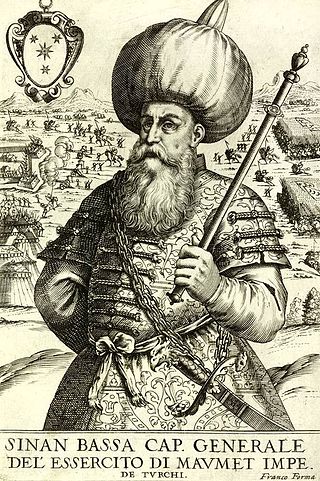
Koca Sinan Pasha was an Albanian-born Ottoman Grand Vizier, military figure, and statesman. From 1580 until his death he served five times as Grand Vizier.

The siege of Negroponte was fought between the forces of the Ottoman Empire, led by Sultan Mehmed II in person, and the garrison of the Venetian colony of Negroponte (Chalcis), the capital of the Venetian possession of Euboea in Central Greece. The Ottoman sultan Mehmed II laid siege to the fortress at Negroponte. It lasted for almost a month, and despite great Ottoman casualties ended in the capture of the city and the island of Euboea by the Ottomans.
The fourth siege of Krujë by the Ottoman Empire of Krujë in Albania occurred in 1478, ten years after the death of the Skanderbeg, and resulted in the town's capture after the failure of three prior sieges and a prolonged siege that lasted a year.
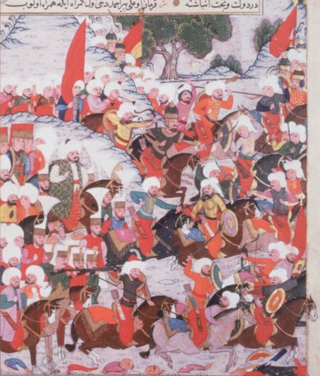
The Battle of Otlukbeli or Otluk Beli was fought between Aq Qoyunlu and the Ottoman Empire on August 11, 1473.

The First Ottoman–Venetian War was fought between the Republic of Venice with its allies and the Ottoman Empire from 1463 to 1479. Fought shortly after the capture of Constantinople and the remnants of the Byzantine Empire by the Ottomans, it resulted in the loss of several Venetian holdings in Albania and Greece, most importantly the island of Negroponte (Euboea), which had been a Venetian protectorate for centuries. The war also saw the rapid expansion of the Ottoman navy, which became able to challenge the Venetians and the Knights Hospitaller for supremacy in the Aegean Sea. In the closing years of the war, however, the Republic managed to recoup its losses by the de facto acquisition of the Crusader Kingdom of Cyprus.
Derviş Mehmed Pasha, an Ottoman Bosnian statesman, served briefly as the Grand Vizier of the Ottoman Empire between 21 June 1606 and 9 December 1606.
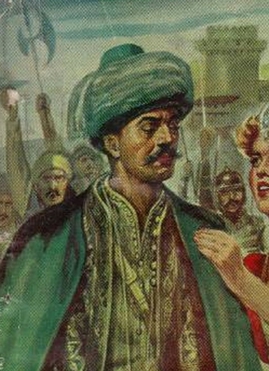
Gazi Hüseyin Pasha, also known as Deli Hüseyin Pasha or Sarı Hüseyin Pasha or Baltaoğlu Hüseyin Pasha, was an Ottoman military officer and statesman. He was governor of Egypt (1635–1637), Kapudan Pasha in the 1630s, and briefly Grand Vizier in 1656.

The siege of Jajce was a siege of the town of Jajce and its citadel in 1463, in a push by Ottomans to conquer as much of the Bosnian Kingdom, and continuation of the Ottoman–Hungarian Wars. After the fall of Travnik and royal fortress of Bobovac, in the initial days of invasion, Ottomans, led by Sultan captured the town. One of the parties pursued Bosnian King Stjepan Tomašević, and caught up with him at Ključ fortress, after which he was brought to Jajce and executed. Soon the Ottomans forces withdraw, leaving the town under the protection of a small garrison. The Hungarian took the opportunity to capture the citadel, and this meant that Ottoman advancement in Bosnia was halted for the time being. The northern part of Bosnia were brought under Hungarian control, and divided into three administrative regions, Banate of Jajce, Banate of Srebrenik, established around Srebrenik fortress, and a puppet statelet named "Bosnian Kingdom". This situation and Jajce under Hungarian garrison will last until 1527 when the Ottomans finally took the town, and breaking the lines advanced northward to Hungary and westward to Bihać, which was part of the Kingdom of Croatia.

Sarı Süleyman Pasha was the grand vizier of the Ottoman Empire from 18 November 1685 to 18 September 1687. He was executed after the defeat of the Ottoman forces in the Second Battle of Mohács.

Cemile Sultan was an Ottoman princess, the daughter of Sultan Abdulmejid I and Düzdidil Hanım. She was the half sister of Sultans Murad V, Abdul Hamid II, Mehmed V, and Mehmed VI.
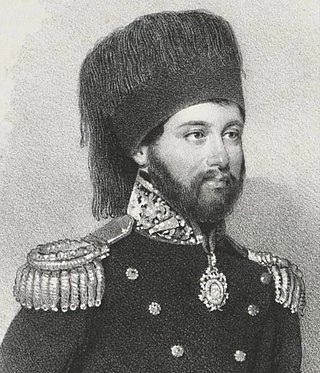
Damat Gürcü Halil Rifat Pasha, was an Ottoman admiral and statesman of Georgian origin. He served in the periods of Mahmud II and Abdulmejid I.
Hümaşah Sultan, also known as Hüma Sultan, was an Ottoman princess, the daughter of Şehzade Mehmed (1521–1543) and the granddaughter of Sultan Suleiman the Magnificent of the Ottoman Empire, and his favourite consort and legal wife Hurrem Sultan.

The siege of Amasra was the land and sea besiegement that resulted in the Ottoman Army, under the command of Fatih Sultan Mehmed, and the Ottoman Navy, under the command of Grand Vizier Veli Mahmud Pasha, capturing the Genoese colony of Amasra, and annexing it into Ottoman lands in 1460.
Feride Hanımsultan was an Ottoman princess, the daughter of Atiye Sultan and Ahmed Fethi Pasha and the granddaughter of the Ottoman Sultan Mahmud II.
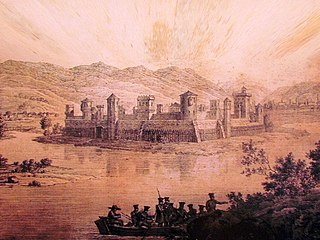
The siege of Smederevo was Mehmed II's assault on the Smederevo Fortress during his fourth Serbian campaign.

The Battle of Kljuc is a pitched battle which took place during the conquest of Bosnia in 1463.

Battle of Kıreli is a battle fought between the Ottoman Empire and Aq Qoyuniu with the Karamanids.

The Battle of Tahtalu took place during the campaign launched by Hungarian king Matthias Corvinus against the Ottomans.
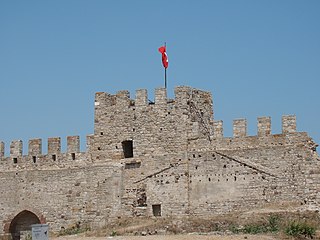
The Aegean Expedition of 1456 was the expedition in which the Ottoman army under the command of Mehmed the Conqueror captured Enez, Lemnos and the island of Samothrace.

















